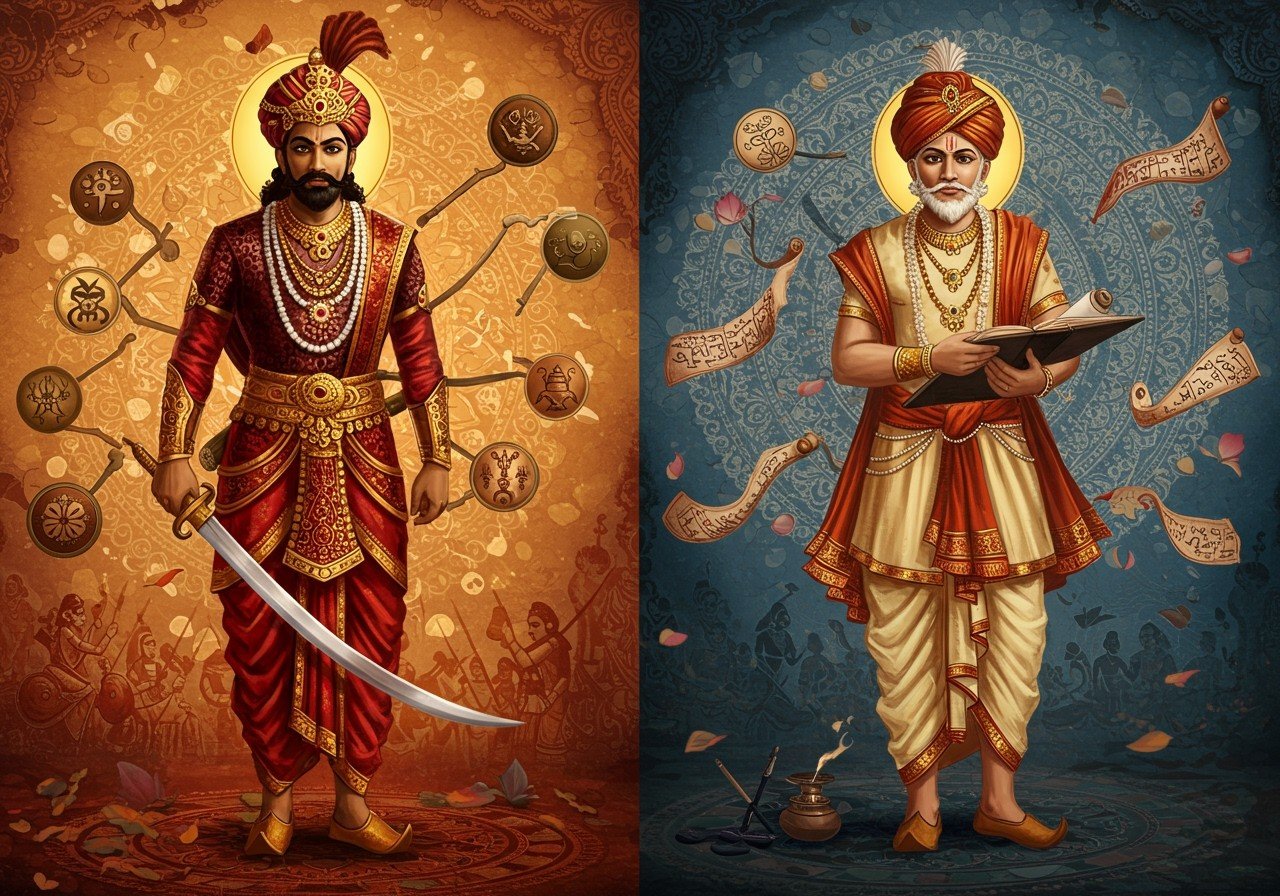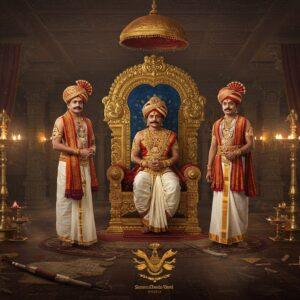
In India, the Kshatriya and Kayastha communities hold a revered place in our history and culture. Each has unique roles and traditions that have evolved over time. For many Indians who deeply value tradition, understanding these communities’ past and present offers a profound connection to our heritage. Exploring their history allows us to appreciate their significant contributions to our society.
The Kshatriya Lineage: Warriors and Leaders
The Kshatriya community’s legacy is deeply rooted in the roles of warriors and rulers in ancient India. As one of the four Varnas in Hinduism, they held a crucial role in safeguarding society. Think of iconic dynasties like the Rajputs and Marathas – they are powerful examples of Kshatriya influence, leaving an indelible mark on Indian history. From wielding swords to navigating the complexities of modern professions, Kshatriyas have gracefully adapted to the changing tides of time.
Traditionally, Kshatriyas held the responsibility of governance, protecting the people, and upholding justice (2025-05-11, 2015-11-25). Their origins are linked to Brahma’s arms in some accounts (2015-11-25), connecting them to lineages from Surya, Chandra, or Saptarishi. We remember iconic figures like Sri Ram and Sri Krishna as part of this rich heritage (2020-11-10). While the image of a warrior may be less defined in today’s world (2020-11-10), the Kshatriya identity remains a source of pride and strength.
The Kayastha Chronicle: Scribes and Administrators
The Kayastha community’s history is equally captivating. Traditionally known as scribes and administrators, they held a distinguished position as a literate class in medieval India. Imagine them as the keepers of knowledge, serving as clerks and accountants in royal courts, playing a vital role in the intricate workings of governance. Their wisdom and meticulous record-keeping were essential for the smooth functioning of kingdoms.
The earliest references to Kayasthas take us back to the Kushan Empire, where the term itself meant “writer” or “scribe”. Some scholars believe they originated in North India and later spread to other regions (2024-04-01). They are considered descendants of Chitragupta, the Hindu god of justice (2017-09-28). During the Mughal era, Kayasthas made significant contributions to Indian literature and governance, adding another layer to their rich tapestry of accomplishments.
Cultural Expressions: Rituals and Traditions
Both Kshatriya and Kayastha communities have distinct cultural practices that reflect their unique identities. Kshatriyas often emphasize martial traditions, with customs like Kshatriya weddings and religious rites that carry deep meaning. Their traditional attire serves as a visible connection to their warrior legacy.
Kayasthas, with their emphasis on education and literature, have shaped their cultural identity around knowledge and scholarship. Their traditional attire, festivals, and ceremonies highlight their intellectual heritage. These distinct expressions of culture enrich the tapestry of Indian tradition.
Modern Roles: Evolving Contributions
In contemporary India, Kshatriyas and Kayasthas continue to hold important socio-economic positions. Kshatriyas are often found in politics and defense, continuing their tradition of service and leadership. Kayasthas maintain a strong presence in education, administration, and corporate sectors, carrying forward their legacy of knowledge and expertise.
Both communities share a deep respect for education and professional success. These shared values have contributed to their socio-economic standing and influence in diverse fields, demonstrating their adaptability and continued relevance in modern India.
Beyond Misconceptions: Embracing the Full Picture
It’s easy to fall prey to common misconceptions about these communities. Some might think Kshatriyas are solely warriors and Kayasthas only scribes. But the reality is far more nuanced. Both communities have diversified their roles in modern professions, embracing a wider range of contributions to society.
Kshatriyas have adapted remarkably to contemporary life, moving beyond traditional roles into diverse fields (2020-11-10). Similarly, Kayasthas are recognized as a well-educated, urban-oriented community making significant contributions in various sectors (n.d., 2024-04-01). Understanding their unique historical and cultural backgrounds allows us to move beyond stereotypes and appreciate the shared values of tradition and education that bind these communities together.
Poojn.in: Honouring Your Heritage
At poojn.in, we understand the importance of preserving and celebrating traditions. We offer a wide selection of puja items and ritual materials essential for both Kshatriya and Kayastha communities.
For Kshatriyas, who value their warrior traditions, we offer items like:
* Brass and copper kalash: Perfect for ceremonial use, adding a touch of tradition to your rituals. Explore our Kalash collection.
* Red thread (mauli): A symbol of protection and blessings, essential for various rituals. Find high-quality Mauli here.
* Pure ghee: For havans and yagyas, ensuring the purity and authenticity of your sacred offerings. Browse our range of pure Ghee.
* Specific incense sticks: Used in traditional Kshatriya ceremonies, creating a sacred atmosphere. Discover our Incense collection.
For Kayasthas, known for their scholarly traditions and reverence for Lord Chitragupta, we offer:
* Special puja items for Dawat puja: Honouring Lord Chitragupta, the divine record-keeper. Find everything you need for Dawat Puja.
* Ink and pen sets: Symbolic of their scholarly heritage, perfect for traditional rituals. Discover unique stationery for rituals.
* Pure copper items: For daily worship, enhancing the sanctity of your puja space. Explore our Copper items.
* Materials for Chitragupta puja: Honouring the divine record-keeper with authentic puja materials. Find all the essentials for Chitragupta Puja.
At poojn.in, you can find authentic ritual items with the convenience of online ordering and pan-India delivery. Our team of experts can assist you in selecting the right items based on your specific community traditions. Contact us at 03369029784 or WhatsApp 9476142738 for personalized assistance.
Visit www.poojn.in to explore our complete range of traditional puja items. We ensure quality and authenticity in all our products, helping you maintain the sanctity of your religious practices.
Embracing the Past, Shaping the Future
As we delve into the stories of the Kshatriya and Kayastha communities, we see how deeply they are woven into the vibrant tapestry of Indian history and culture. Both communities have beautifully blended their traditional values with modern aspirations. This journey through time reveals their unique contributions to our society, dispelling common myths and painting a more complete picture of their diverse roles in today’s world.
For Indians who cherish their heritage, understanding these communities deepens our appreciation for tradition. It also highlights the shared values of education and professional success that propel them forward. By recognizing their ongoing evolution, we embrace a harmonious blend of past and present, ensuring these storied legacies continue to inspire generations to come. In this way, we can celebrate our rich heritage while confidently stepping into modernity, knowing our traditions serve as a strong foundation for growth and progress.
Understanding the Nuances: Kshatriya and Kayastha
Let’s explore some common questions about these communities:
What distinguishes Kshatriyas and Kayasthas? Kshatriyas are traditionally warriors and rulers, upholders of dharma and protectors of the realm. Kayasthas are known for their intellect and administrative skills, serving as scribes, record-keepers, and advisors. Kshatriyas belong to the traditional varna system, while Kayasthas’ position within it is more complex and debated (2017-09-28, 2024-04-01, 2018-04-17).
Are Kshatriyas and Kayasthas the same? No. They are distinct communities with separate historical roles and social identities. While both have contributed significantly to Indian society, their traditional occupations and origins differ (2025-05-11, 2015-11-25, 2020-11-10).
Where do Kshatriyas come from? Kshatriya origins are rooted in ancient Vedic society as one of the four varnas. They were responsible for protection and governance, their lineage often traced back to mythological and historical figures like Sri Ram and Sri Krishna (2015-11-25, 2020-11-10).
What is the origin of Kayasthas? Kayasthas emerged as a community known for literacy and administrative abilities. They played key roles in governance, serving as record-keepers and clerks, particularly during medieval India. They are considered descendants of Chitragupta (n.d., 2017-09-28).
Which community is larger? Population sizes vary based on region and historical migrations. While both communities have a significant presence across India, Kshatriyas are generally considered to be more widespread.
Do they share similar cultural practices? While regional influences might create some overlap, Kshatriya and Kayastha communities often have distinct cultural practices, rituals, and traditions reflecting their unique histories and geographical locations.
Can a Kayastha become a Kshatriya? Traditionally, these identities are inherited. However, in modern India, social distinctions are less rigid, with individuals pursuing professions and lifestyles regardless of traditional community roles. Today, personal choice and accomplishment often define an individual’s path rather than strict adherence to traditional roles.


